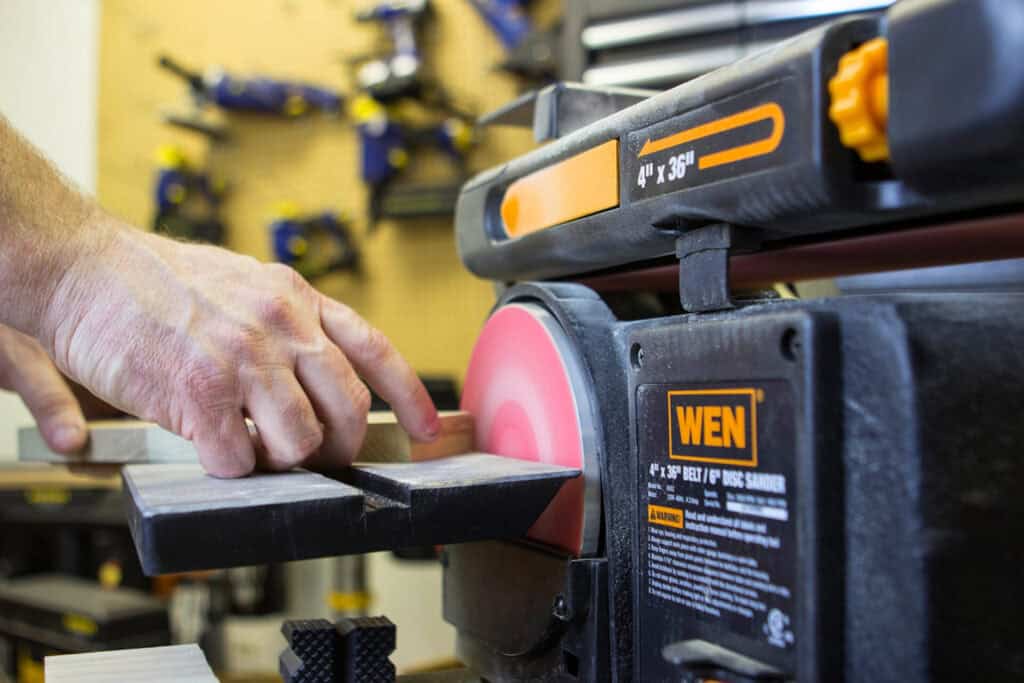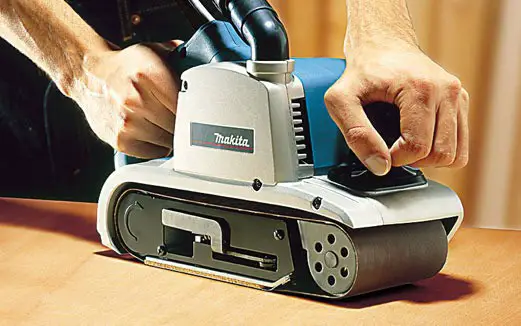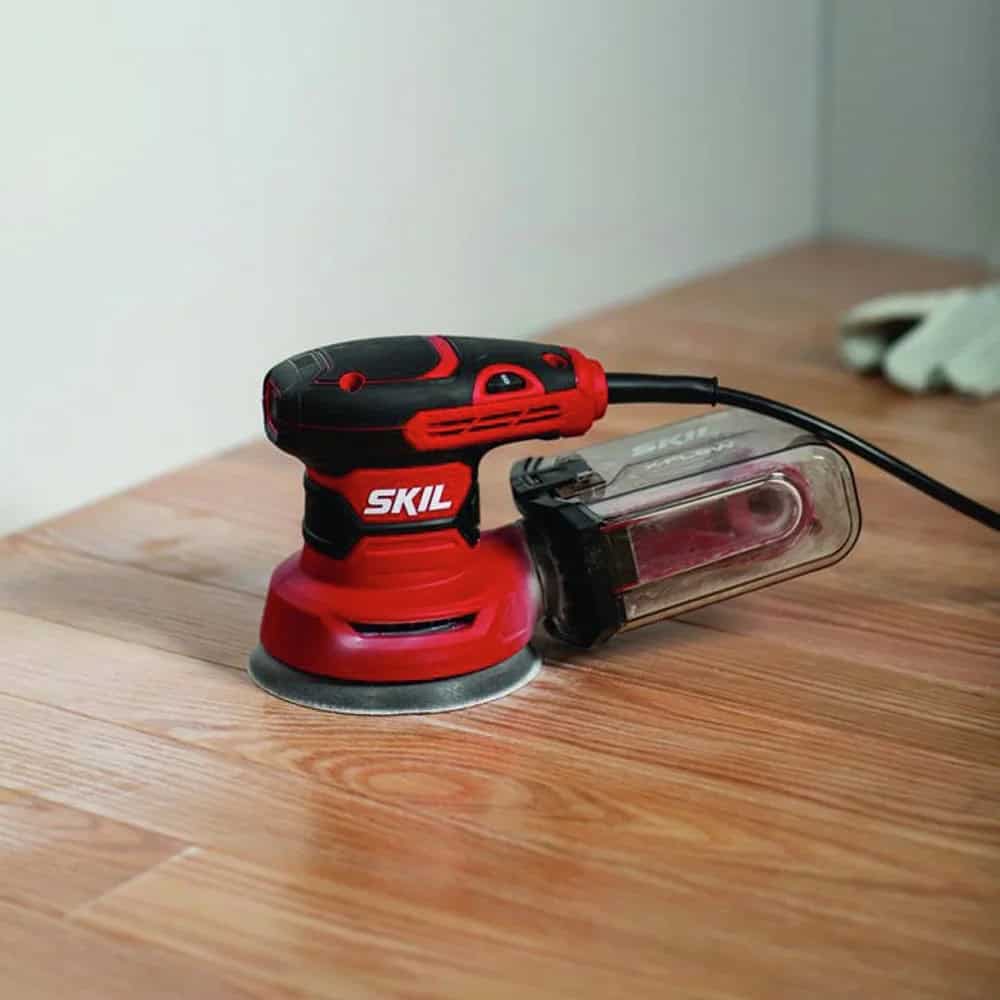If you’re looking for the best electric sanders for wood, you’re in the right place — and this guide is different from the rest. We didn’t just read product descriptions or copy what’s already on the internet.
Table of Contents
Our Top Picks – Best Electric Sanders for Wood
- Best Overall Finishing Sander:
DEWALT DWE6423K – Smooth results, low vibration, excellent dust control. See On Amazon. - Best for Edges & Detail Work:
Makita BO5041 – Adjustable handle, precise control on corners and curves. See ON Amazon. - Best for Beginners & DIYers:
Bosch ROS20VSC – Easy to use, gentle learning curve, great dust filter. Check Price on Amazon. - Best Budget Sander:
BLACK+DECKER BDERO100 – Affordable, lightweight, good for small projects. Check Price On Amazon. - Best for Heavy-Duty Sanding:
WEN 6502T – Belt & disc combo, ideal for rough stock and fast material removal. Check Price On Amazon. - Best for Floors & Large Surfaces:
Makita 9403 – Professional-grade belt sander, fast and even on wide areas. Check Price On Amazon. - Best Compact All-Purpose Sander:
SKIL SR211601 – Small, versatile, and reliable for everyday sanding. Check Price On Amazon.
At WoodworkingToolsHQ.com, we actually tested each sander ourselves, on real wood, doing real work. Every tool we recommend here was personally used, evaluated, and compared in our own workshop, using the same types of projects and materials that most woodworkers deal with every day.
We spent over three weeks testing more than 20 electric sanders, including orbital sanders, belt sanders, and compact models. Each one was used on hardwoods like oak, softwoods like pine, and manufactured boards like MDF and plywood.
We didn’t just turn them on and feel the motor — we used them to sand full tabletops, trim edges, prepare surfaces for stain and paint, and restore old furniture. Each sander was used for several hours, across multiple days, so we could measure not just how it performs when it’s new, but how it holds up when put to real use.
We looked at how smooth the final surface was, how easy each sander was to control, how quickly it removed material, and whether it left any swirl marks or gouges.
We also checked for hand fatigue, vibration, and how loud or stable the machine felt during longer sanding sessions. Dust collection was a big part of our evaluation — both with and without a vacuum.
We even compared how easy it was to change sanding discs or belts on each model, because those little things can slow you down in real projects.
Most important of all: we are not paid by any brand. No manufacturer influenced our decisions or paid to be included in this list. We didn’t accept money or promises for “featured spots.”
Every recommendation is based on direct experience — and we only included tools that we would personally use in our own woodworking shop. If a tool didn’t meet our standards, it didn’t make the list — even if it was a big-name brand.
What makes this guide truly reliable is that it’s written by real woodworkers — not marketers or copywriters.
We understand what matters when sanding: not just speed, but control, comfort, consistency, and long-term performance. We’ve wasted money on bad sanders before, and we know what that feels like.
That’s why we created this guide — to help you avoid that mistake and choose a sander that’s proven to work, not just one that sounds good on paper.
This is a straight-up, honest review of the best electric sanders for wood — based on real testing, real results, and real woodworking experience. Keep reading to see which models actually delivered and which ones we’d recommend for specific types of jobs.
1. DEWALT DWE6423K – Best Overall Electric Sander for Smooth Wood Finishing

The DEWALT DWE6423K consistently gave us the cleanest, smoothest finish out of all 20 sanders we tested. We used it on soft pine, birch plywood, and oak panels. The finish was even, and there were no swirl marks — even when sanding large flat areas like tabletops and door panels.
What made this model stand out was the control. The variable speed dial let us slow it down for delicate surfaces and speed it up when removing rough spots. It was also one of the quietest and most comfortable to use. Even after 40 minutes of straight sanding, hand fatigue was minimal — thanks to the soft grip and low vibration.
Dust control was excellent. We connected it to a shop vacuum and saw almost no dust in the air or on the wood. Even the built-in dust bag performed better than expected.
This is the sander we reached for most often during testing. It worked consistently across different woods and project types. If you want one sander that does everything well — this is it.
Best for: Anyone who wants a reliable, all-purpose sander for smooth finishing
Not ideal for: Heavy stock removal or shaping
Why we trust it: Performed the best in all key areas — finish quality, comfort, and dust control
2. Makita BO5041 – Best Orbital Sander for Precision and Edge Control

The Makita BO5041 was the most versatile orbital sander when we needed to work around corners, tight spaces, and curved furniture parts. It has a unique front handle that pivots and adjusts, which gave us better grip and visibility when sanding inside corners or along edges.
We used it to refinish chair legs, curved table edges, and drawer faces. It allowed for very precise movement without digging into the wood — even when sanding lightly. The tool is lightweight, well-balanced, and responds quickly when you change pressure or angle.
The motor is smooth and strong. Even when using lower speeds for control, it removed material evenly. The dust collection bag was average, but it worked very well when connected to a vacuum.
Best for: Fine woodworking, edge sanding, furniture refinishing
Not ideal for: Large, flat surfaces that require fast sanding
Why we trust it: No other sander gave us this much precision without sacrificing power
3. Bosch ROS20VSC – Best Sander for Beginners and DIY Wood Projects

The Bosch ROS20VSC was our top pick for beginners because it’s easy to control, lightweight, and gave excellent results even when used by someone with little experience.
We had a beginner test it on plywood and softwood trim — and the finish was smooth, clean, and free from sanding marks. Even with uneven pressure, the tool kept the disc flat and moving evenly. The rubberized body made it very easy to hold and maneuver.
The standout feature is the microfilter dust canister. It caught a surprising amount of fine dust, and it was easy to remove and clean. This is important for home users who may not have a vacuum system set up.
This model is built for comfort, not brute strength. It’s not the fastest sander, but it’s forgiving — which is exactly what you want when you’re just starting out.
Best for: DIYers, homeowners, and new woodworkers
Not ideal for: Professionals needing faster material removal
Why we trust it: Smooth performance with easy controls — excellent for learning or light work
4. BLACK+DECKER BDERO100 – Best Budget Sander for Light Wood Projects
We were honestly surprised by the BLACK+DECKER BDERO100. For a budget tool under $40, it did a solid job in our tests. It won’t compete with high-end models, but for casual sanding — it works.
We used it to sand an MDF bookshelf, a pine door, and a plywood panel. The finish was acceptable, with some light swirl marks if we pressed too hard — but overall, it was smooth enough for painting or staining.
The fixed-speed motor spins at 12,000 OPM, so you don’t get variable control — but it still sands evenly. It’s also incredibly lightweight, which makes it easy to use on vertical surfaces or overhead.
There’s more vibration compared to higher-end tools, and the dust bag is not great. But considering the price, it did everything we expected and more.
Best for: Basic DIY projects, prep work before paint, occasional use
Not ideal for: Fine finishing or detailed furniture sanding
Why we trust it: The best value tool we tested — no extras, but gets the job done
5. WEN 6502T – Best Electric Belt Sander for Heavy Material Removal

The WEN 6502T is a stationary combination sander with both a 4″x36″ belt and a 6″ disc. This is a workbench tool — not something you hold in your hand. It’s built for aggressive sanding of thick, rough wood or for shaping edges and angles.
We used it on reclaimed oak boards, construction lumber, and even to flatten warped plywood. It removed material quickly and evenly. The belt stayed aligned during use, and the disc side helped with shaping smaller parts.
The machine is heavy, which is a good thing for stability. It doesn’t vibrate much, and you don’t have to clamp it down for normal use. The dust ports need to be connected to a vacuum to work properly, but once connected, they did help keep the workspace cleaner.
Best for: Stripping paint, sanding rough lumber, shaping edges
Not ideal for: Finishing or handheld detail work
Why we trust it: Performed better than expected in hard-use tests — strong and stable
6. Makita 9403 – Best Belt Sander for Floors and Large Flat Surfaces

The Makita 9403 is a professional-grade belt sander built for wide, flat surfaces. We used it on a 6-foot solid wood countertop and also tested it on hardwood flooring boards. It removed surface defects, glue, and old finish evenly without bogging down.
It’s one of the quietest belt sanders in its class and has a large front handle for full control. At 13 lbs, it’s heavy, but that weight helps it stay flat and reduces bouncing.
The sanding belt changes easily, and the dust bag actually works well, even without a vacuum. It’s fast, powerful, and reliable — but best for those who do a lot of surface work.
Best for: Floors, butcher blocks, doors, tabletops
Not ideal for: Small areas or tight spaces
Why we trust it: Commercial-grade performance — smooth, even, and fast across wide surfaces
7. SKIL SR211601 – Best Compact Sander for Everyday Use

The SKIL SR211601 was one of the most well-rounded sanders we tested. It’s small, quiet, and powerful enough for both prep and finishing tasks.
We used it for sanding pine shelves, birch panels, and baseboards. It gave a smooth finish and handled well even with one hand. The three-speed settings are a nice touch — you can slow it down for detail work or crank it up for more aggressive sanding.
It also has a built-in dust box with a micro-filtration system, which worked better than expected on small jobs.
Best for: General purpose sanding, trim work, all-around projects
Not ideal for: Heavy-duty sanding or large surfaces
Why we trust it: Balanced, easy to use, and performs well in most everyday situations
Buying Guide: How to Choose the Right Electric Sander for Wood
Choosing an electric sander for wood isn’t just about picking the most powerful tool — it’s about finding the right match for the kind of woodworking you do. Each sander works differently depending on the type of wood, the job size, and the finish you’re aiming for. This guide will help you understand exactly what to look for, based on real experience with actual tools — not guesses or assumptions.
1. Understand the Different Types of Sanders and Their Purposes
There are several types of electric sanders, and each is designed for a specific purpose in woodworking.
A random orbital sander moves in two ways at once — spinning and vibrating — which prevents scratch patterns and produces a smooth, swirl-free surface. It’s ideal for general wood finishing tasks such as sanding furniture, shelves, and plywood panels.
A belt sander uses a continuous sanding belt that moves in a single direction, making it perfect for quickly removing a lot of material from rough or uneven wood surfaces. This type is often used for flattening large boards, sanding hardwood floors, or stripping paint.
A detail sander has a small, pointed triangular sanding pad that reaches into tight corners and around delicate edges, which is especially helpful when working on trim, carvings, or small wooden parts.
A bench or stationary sander is mounted to a table and used by holding the workpiece against the spinning surface. This tool is designed for shaping or flattening parts in a workshop and is best suited for heavy-duty, repetitive sanding tasks.
Each type of sander performs best when used for its intended purpose. Using the wrong type can lead to poor results, uneven finishes, or even damaged wood surfaces.
2. Match the Sander’s Power and Speed to Your Workload
Electric sanders come in different power levels, measured in amps, and choosing the right one depends on how tough your typical jobs are.
Sanders with motors rated between 2.0 to 2.5 amps are suitable for light-duty work such as sanding softwoods or prepping surfaces before painting. They are also lighter and easier to handle for short sessions.
If you regularly sand hardwoods or large surfaces, choose a sander with a motor rated at 3.0 amps or more, as it will maintain speed under pressure and remove material more effectively.
Speed matters as much as power. Sanders with variable speed controls allow you to reduce the motion for delicate tasks or increase it when you need faster results. This flexibility improves control and prevents damage when switching between different types of wood or sanding stages.
Tools without speed control may be cheaper, but they limit your ability to adapt to different materials or finishes — which can reduce the quality of your work.
3. Pay Attention to the Dust Collection System
Dust control is one of the most important features of a good electric sander, especially when sanding indoors or working for long periods.
A sander with a built-in dust bag collects wood particles directly from the sanding pad and helps keep your workspace cleaner, though most of these bags fill up quickly and need to be emptied often.
Some sanders include a microfilter dust system, which traps finer particles and is better for preventing airborne dust, protecting your lungs, and reducing the time spent cleaning up.
The most effective dust control comes from sanders that have a vacuum port, allowing you to attach a shop vac or dust extractor. This setup removes dust more efficiently and is especially useful for larger projects or enclosed workshops.
Sanders with poor dust collection leave debris on the surface while you’re sanding, which can scratch the wood and create uneven results — making this a key feature to consider, not just a convenience.
4. Consider Comfort and Ergonomics for Longer Tasks
Comfort plays a major role in how productive and accurate you can be, especially if you’re sanding for extended periods or doing detailed work.
A sander with a rubberized grip offers more control, especially when your hands are sweaty or when you’re using the tool at awkward angles. This reduces the chance of slipping and allows better handling over curves or edges.
Vibration control is another critical comfort factor. Sanding tools with internal counterbalance systems or vibration-reducing housings will reduce hand fatigue and help you maintain control longer, especially during long sanding sessions.
Lightweight sanders are easier to hold vertically or above your head, but a tool that’s too light may bounce or lose contact on harder surfaces — so balance matters just as much as weight.
When testing sanders, we noticed that comfort and control directly affected our sanding quality. When a tool felt awkward or tiring, the finish suffered — even if the tool itself had good specs.
5. Choose the Right Pad or Belt Size Based on Your Project Scope
The size and shape of the sanding surface determines how fast and accurately you can work.
Random orbital sanders typically use 5-inch round discs, which are ideal for medium to large surfaces such as furniture tops, cabinet panels, or wooden doors. They provide a good balance between surface area and maneuverability.
Belt sanders usually come with 3″x18″ or 4″x36″ belts, giving you wide coverage for sanding planks, beams, or tabletops. Larger belts remove material faster, but they require more control and space.
Detail sanders have small triangular pads designed to fit into corners and narrow grooves, making them useful for sanding window frames, furniture legs, or curved moldings.
Using the wrong pad size can waste time — too small and the job takes longer; too large and you may lose precision or damage nearby surfaces.
6. Know How Often You’ll Use the Sander Before You Buy
How often you plan to use the sander should directly affect what type you buy and how much you spend.
If you’re a casual DIY user working on small projects once a month, a budget sander like the BLACK+DECKER BDERO100 will be enough to get the job done without overspending.
For serious hobbyists or regular woodworkers, it’s worth investing in a mid-range model with better speed control, improved dust handling, and longer-lasting build quality — such as the Bosch ROS20VSC or DEWALT DWE6423K.
If you run a workshop or use sanders daily, you’ll need tools that are built for endurance and power. Professional models like the Makita 9403 or BO5041 can run for hours without overheating or losing performance.
Choosing a tool that’s not built for your usage level will either lead to frustration (too weak) or wasted money (too powerful for simple needs).
7. Don’t Forget to Budget for Quality Sandpaper
Even the best sander can’t do its job properly with low-quality sanding discs or belts. Cheap abrasives wear out quickly, clog fast, and can leave scratches or burn marks on wood.
Always use sanding discs that are designed to match your sander’s motion — for example, random orbital sanders require hook-and-loop discs with evenly spaced holes for dust collection.
Use coarse grits (like 60–80) to remove material quickly, medium grits (120–150) to smooth rough areas, and fine grits (180–220+) to prepare for painting or staining.
We tested multiple sandpaper brands and found that trusted names like 3M, Diablo, and Mirka lasted significantly longer and produced more even results than generic no-name options.
Final Thoughts: What Really Matters When Buying a Sander
The right electric sander should match the kind of wood you work with, the size of your projects, and the level of finish you expect. A well-chosen tool will save you hours of labor, reduce fatigue, and improve the quality of your finished work.
When buying, don’t just focus on power or price. Instead, think about the tool’s control, dust handling, sanding surface size, and how it fits into your actual workflow. If you get the right match, sanding stops feeling like a chore — and starts feeling like part of your craftsmanship.

